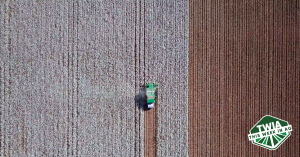While farmer sentiment may be down, their appetite for new information is not. Initial estimates had last week’s Commodity Classic drawing record crowds, with projections of 11,000 attending the event in Houston. It’s nearly impossible to upstage John Deere at such an event, and big green’s launch of four new products stole the headlines. Their green beanies featuring the new 830-horsepower tractor were highly sought after. Stretching across their entire booth was a new 850-bushel air seeder attached to the 9RX tracked-tractor. Upon seeing it on display, farmers friends and I joked about the prospect of even roading such a monstrosity down small and winding roads. In talking to a friend who is editor of a prominent farm magazine, I asked what stood out to him (other than the green machines) at the show. He said the attention and interest in biological products was his key takeaway. In listening to commodity association leaders and the USDA Ag Secretary, aviation fuel is an exciting market opportunity. Yet to the chagrin attendees, no official announcement on SAF was made. The Secretary did say that details would be released in a matter of weeks, not months. Talk of the Farm Bill was heard throughout the week, but few have much confidence in much happening until after the election. Crop insurance continues to be the top priority. When legislation finally comes to the floor, there will be over 400 congressmen who have never voted on a Farm Bill. Overall, low commodity prices and high input prices had farmers searching for solutions.
This was the first year for Huma to display our new brand at Commodity Classic. We seemed to make quite a splash with our attention-grabbing booth. There was a steady flow of interested visitors, especially on the first day. We received strong praise from both friends and newcomers. There seems to be a growing interest in humics and what they can offer. Knowledge varies, but minds appear open. We fielded lots of questions on improving soil health, managing manure, utilizing in-furrow application and replacing synthetic products. We even got questions about using liquid products with drones.
Few brands in history have risen to dominance like Toyota. In 1986, the Japanese automaker became the first foreign brand to sell over 1 million cars in the US. By 2008, it took over the top spot in America. And the past four years running Toyota is number-one in the world. Reliability and quality are hallmarks. But their long-term vision and insight into customer preferences have made them legendary. They seem to know things their competitors don’t. Perhaps this is the case with electric vehicles. Many are predicting the demise of the internal combustion engine. But not Toyota. Chairman Akio Toyoda doubled down on his belief that EV cars will max out at 30% of the US market (some European markets have surpassed 30%). He believes the future is in hybrid models, which combines reliability with fuel-saving capabilities. This position is not popular with some climate advocates, who view EV as a singular approach to meeting their goals. However, Japan is the only developed nation to lower carbon emissions by 23%, largely due to hybrid vehicles which account for over half of the country’s auto sales. One group that is lauding Toyota’s strategy is corn growers. Hybrid vehicles provide a continued market for corn-based ethanol, which serves as the destination for 38% of US corn production.
Our hearts go out to ranchers and farmers across the Texas Panhandle who are experiencing catastrophic losses. More than 1.1 million acres have been burned by wildfires. Winds continue to whip the blaze across dry grasses, as only 15% of the fires have been contained. Thousands of cattle have perished, which will further lessen the shrinking US herd, already at a 70-year low. Momma cows are valued at about $3,000 a piece. Then there’s the structural damage. A mile of fence can cost more than $10,000 to replace. Supplies of hay and feed have been ravaged, as have growing wheat crops.
Related Posts

Strawberry Sweet, Corn Still Sleeping
Strawberry Sweet, Corn Still Sleeping: In celebration of National Strawberry Month, I visited Catesa Farms, where flavor—not shelf life—is the top priority. Meanwhile, back on my own farm, the corn is taking its sweet time to emerge, reminding me that in agriculture, timing is all about temperature—not the calendar.

Global Fertilizer Day Is October 13
Global Fertilizer Day: Join us in celebrating the world's farmers. They have set themselves the almost impossible task of feeding more and more people while using less land and fewer resources.

This Week in Ag #86
Yesterday was #WorldCottonDay. That’s a fitting title, considering how creating the world’s most popular fabric is truly a world endeavor. Cotton is a crop mostly grown in Asia and the Americas, whose end products are mostly designed in Europe and mostly manufactured in Asia, and largely consumed in the world’s wealthiest countries (the USA accounts

